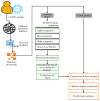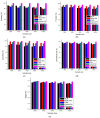A Novel COVID-19 Diagnostic System Using Biosensor Incorporated Artificial Intelligence Technique
- PMID: 37296738
- PMCID: PMC10252377
- DOI: 10.3390/diagnostics13111886
A Novel COVID-19 Diagnostic System Using Biosensor Incorporated Artificial Intelligence Technique
Abstract
COVID-19, continually developing and raising increasingly significant issues, has impacted human health and caused countless deaths. It is an infectious disease with a high incidence and mortality rate. The spread of the disease is also a significant threat to human health, especially in the developing world. This study suggests a method called shuffle shepherd optimization-based generalized deep convolutional fuzzy network (SSO-GDCFN) to diagnose the COVID-19 disease state, types, and recovered categories. The results show that the accuracy of the proposed method is as high as 99.99%; similarly, precision is 99.98%; sensitivity/recall is 100%; specificity is 95%; kappa is 0.965%; AUC is 0.88%; and MSE is less than 0.07% as well as 25 s. Moreover, the performance of the suggested method has been confirmed by comparison of the simulation results from the proposed approach with those from several traditional techniques. The experimental findings demonstrate strong performance and high accuracy for categorizing COVID-19 stages with minimal reclassifications over the conventional methods.
Keywords: COVID-19; artificial intelligence; biosensor; feature extraction; hyperparameter; optimization.
Conflict of interest statement
The authors declare that there are no competing interests.
Figures









Similar articles
-
Artificial Intelligence-Based Traditional Chinese Medicine Assistive Diagnostic System: Validation Study.JMIR Med Inform. 2020 Jun 15;8(6):e17608. doi: 10.2196/17608. JMIR Med Inform. 2020. PMID: 32538797 Free PMC article.
-
A new composite approach for COVID-19 detection in X-ray images using deep features.Appl Soft Comput. 2021 Nov;111:107669. doi: 10.1016/j.asoc.2021.107669. Epub 2021 Jul 5. Appl Soft Comput. 2021. PMID: 34248447 Free PMC article.
-
Human monkeypox diagnose (HMD) strategy based on data mining and artificial intelligence techniques.Comput Biol Med. 2023 Jan;152:106383. doi: 10.1016/j.compbiomed.2022.106383. Epub 2022 Dec 2. Comput Biol Med. 2023. PMID: 36481764 Free PMC article.
-
Biphasic majority voting-based comparative COVID-19 diagnosis using chest X-ray images.Expert Syst Appl. 2023 Apr 15;216:119430. doi: 10.1016/j.eswa.2022.119430. Epub 2022 Dec 21. Expert Syst Appl. 2023. PMID: 36570382 Free PMC article. Review.
-
Artificial intelligence as a fundamental tool in management of infectious diseases and its current implementation in COVID-19 pandemic.Environ Sci Pollut Res Int. 2021 Aug;28(30):40515-40532. doi: 10.1007/s11356-021-13823-8. Epub 2021 May 25. Environ Sci Pollut Res Int. 2021. PMID: 34036497 Free PMC article. Review.
Cited by
-
Nanomaterial-Based Biosensors for the Detection of COVID-19.Indian J Microbiol. 2025 Mar;65(1):120-136. doi: 10.1007/s12088-024-01336-0. Epub 2024 Jun 23. Indian J Microbiol. 2025. PMID: 40371045
-
Sensing the Future-Frontiers in Biosensors: Exploring Classifications, Principles, and Recent Advances.ACS Omega. 2024 Dec 6;9(50):48918-48987. doi: 10.1021/acsomega.4c07991. eCollection 2024 Dec 17. ACS Omega. 2024. PMID: 39713646 Free PMC article. Review.
-
Innovative applications of artificial intelligence in zoonotic disease management.Sci One Health. 2023 Nov 3;2:100045. doi: 10.1016/j.soh.2023.100045. eCollection 2023. Sci One Health. 2023. PMID: 39077042 Free PMC article. Review.
References
-
- Mehta N.S., Mytton O.T., Mullins E.W., Fowler T.A., Falconer C.L., Murphy O.B., Langenberg C., Jayatunga W.J.P., Eddy D.H., Nguyen-Van-Tam J.S. SARS-CoV-2 (COVID-19): What do we know about children? A systematic review. Clin. Infect. Dis. 2020;71:2469–2479. doi: 10.1093/cid/ciaa556. - DOI - PMC - PubMed
-
- Nasreen S., Chung H., He S., Brown K.A., Gubbay J.B., Buchan S.A., Fell D.B., Austin P.C., Schwartz K.L., Sundaram M.E. Effectiveness of COVID-19 vaccines against symptomatic SARS-CoV-2 infection and severe outcomes with variants of concern in Ontario. Nat. Microbiol. 2022;7:379–385. doi: 10.1038/s41564-021-01053-0. - DOI - PubMed
Grants and funding
LinkOut - more resources
Full Text Sources

